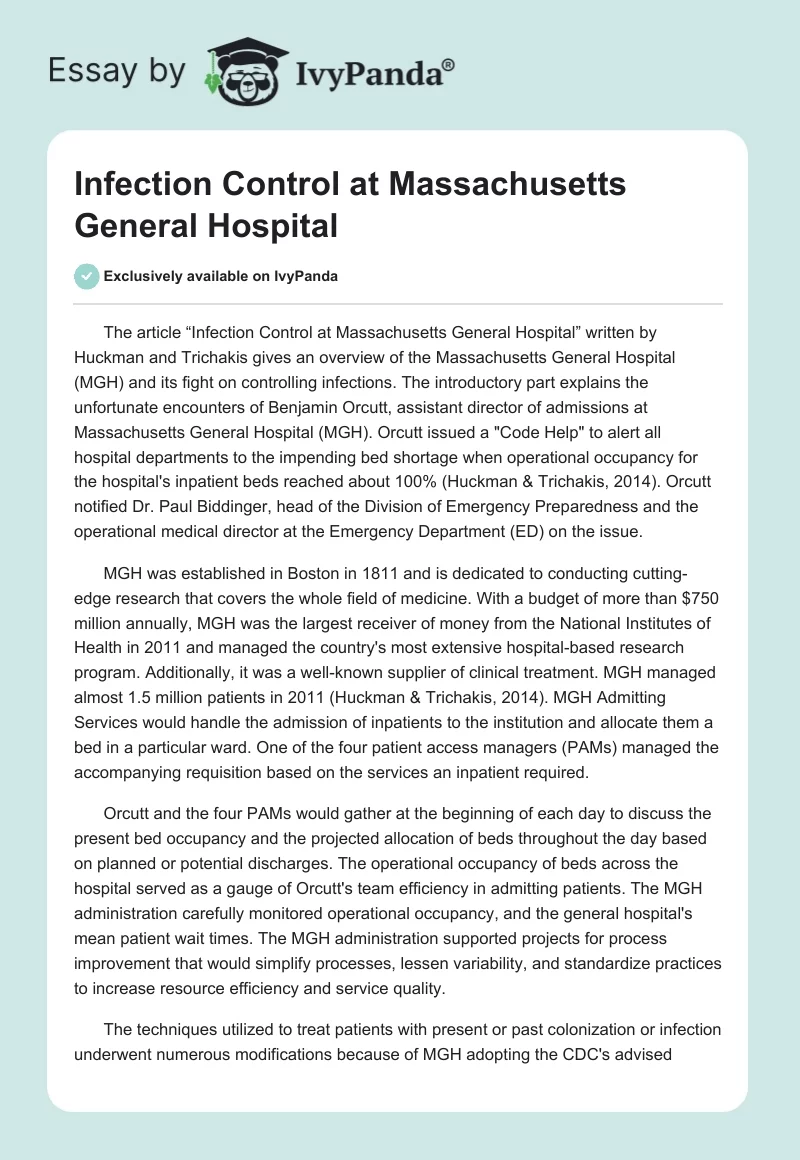The article “Infection Control at Massachusetts General Hospital” written by Huckman and Trichakis gives an overview of the Massachusetts General Hospital (MGH) and its fight on controlling infections. The introductory part explains the unfortunate encounters of Benjamin Orcutt, assistant director of admissions at Massachusetts General Hospital (MGH). Orcutt issued a “Code Help” to alert all hospital departments to the impending bed shortage when operational occupancy for the hospital’s inpatient beds reached about 100% (Huckman & Trichakis, 2014). Orcutt notified Dr. Paul Biddinger, head of the Division of Emergency Preparedness and the operational medical director at the Emergency Department (ED) on the issue.
MGH was established in Boston in 1811 and is dedicated to conducting cutting-edge research that covers the whole field of medicine. With a budget of more than $750 million annually, MGH was the largest receiver of money from the National Institutes of Health in 2011 and managed the country’s most extensive hospital-based research program. Additionally, it was a well-known supplier of clinical treatment. MGH managed almost 1.5 million patients in 2011 (Huckman & Trichakis, 2014). MGH Admitting Services would handle the admission of inpatients to the institution and allocate them a bed in a particular ward. One of the four patient access managers (PAMs) managed the accompanying requisition based on the services an inpatient required.
Orcutt and the four PAMs would gather at the beginning of each day to discuss the present bed occupancy and the projected allocation of beds throughout the day based on planned or potential discharges. The operational occupancy of beds across the hospital served as a gauge of Orcutt’s team efficiency in admitting patients. The MGH administration carefully monitored operational occupancy, and the general hospital’s mean patient wait times. The MGH administration supported projects for process improvement that would simplify processes, lessen variability, and standardize practices to increase resource efficiency and service quality.
The techniques utilized to treat patients with present or past colonization or infection underwent numerous modifications because of MGH adopting the CDC’s advised approach to contact precautions. An expanding body of research has shown that CP is linked to poorer patient care, involving reduced patient-provider engagement and more avoidable adverse events. The majority of patients receiving care under CP at MGH merely had a history of infection or colonization with methicillin-resistant Staphylococcus aureus (MRSA).
The patients might not have needed CP because they were no more colonized as a result. With the invention of Polymerase Chain Reaction (PCR) used in clinical microbiology by the late 2000s, a change had already started (Huckman & Trichakis, 2014). With the discovery of PCR assays that could be run on nasal samples, this breakthrough in MRSA screening became possible and promised to boost detection sensitivity while drastically cutting processing time to about two hours.
Shenoy and Hooper started reworking MGH’s screening procedures for the test program in 2011 when improvements to RICAS were nearly finished, and the PCR device was up and running. Shenoy and Hooper had to find other solutions since, despite their mistakes, they still believed that PCR screening should be implemented in the ED. The first alternative they thought of was to request a new, full-time physician assistant (PA) for the emergency department (ED), who would be in charge of organizing the MRSA inspection in the ED. The second option was to entrust one of the ED’s clinical research directors (CRCs) with organizing the screening.
Reference
Huckman, R., & Trichakis, N. (2014). Infection control at Massachusetts General Hospital.Havard Business School, 1-17. Web.


